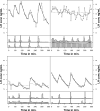A population-based approach to analyzing pulses in time series of hormone data
- PMID: 28393373
- PMCID: PMC5616190
- DOI: 10.1002/sim.7292
A population-based approach to analyzing pulses in time series of hormone data
Abstract
Studies of reproductive physiology involve rapid sampling protocols that result in time series of hormone concentrations. The signature pattern in these times series is pulses of hormone release. Various statistical models for quantifying the pulsatile release features exist. Currently these models are fitted separately to each individual and the resulting estimates averaged to arrive at post hoc population-level estimates. When the signal-to-noise ratio is small or the time of observation is short (e.g., 6 h), this two-stage estimation approach can fail. This work extends the single-subject modelling framework to a population framework similar to what exists for complex pharamacokinetics data. The goal is to leverage information across subjects to more clearly identify pulse locations and improve estimation of other model parameters. This modelling extension has proven difficult because the pulse number and locations are unknown. Here, we show that simultaneously modelling a group of subjects is computationally feasible in a Bayesian framework using a birth-death Markov chain Monte Carlo estimation algorithm. Via simulation, we show that this population-based approach reduces the false positive and negative pulse detection rates and results in less biased estimates of population-level parameters of frequency, pulse size, and hormone elimination. We then apply the approach to a reproductive study in healthy women where approximately one-third of the 21 subjects in the study did not have appropriate fits using the single-subject fitting approach. Using the population model produced more precise, biologically plausible estimates of all model parameters. Copyright © 2017 John Wiley & Sons, Ltd.
Keywords: Bayesian; birth-and-death MCMC; hierarchical models; luteinizing hormone; reproductive hormones.
Copyright © 2017 John Wiley & Sons, Ltd.
Figures


Similar articles
-
Bayesian analysis improves pulse secretion characterization in reproductive hormones.Syst Biol Reprod Med. 2018 Feb;64(1):80-91. doi: 10.1080/19396368.2017.1411541. Epub 2017 Dec 29. Syst Biol Reprod Med. 2018. PMID: 29287490 Free PMC article.
-
A Bayesian approach to modeling associations between pulsatile hormones.Biometrics. 2009 Jun;65(2):650-9. doi: 10.1111/j.1541-0420.2008.01117.x. Biometrics. 2009. PMID: 18759850 Free PMC article.
-
Data cloning: easy maximum likelihood estimation for complex ecological models using Bayesian Markov chain Monte Carlo methods.Ecol Lett. 2007 Jul;10(7):551-63. doi: 10.1111/j.1461-0248.2007.01047.x. Ecol Lett. 2007. PMID: 17542934
-
Statistical inference for stochastic simulation models--theory and application.Ecol Lett. 2011 Aug;14(8):816-27. doi: 10.1111/j.1461-0248.2011.01640.x. Epub 2011 Jun 17. Ecol Lett. 2011. PMID: 21679289 Review.
-
A review of multistate modelling approaches in monitoring disease progression: Bayesian estimation using the Kolmogorov-Chapman forward equations.Stat Methods Med Res. 2021 May;30(5):1373-1392. doi: 10.1177/0962280221997507. Epub 2021 Apr 7. Stat Methods Med Res. 2021. PMID: 33826459 Free PMC article. Review.
Cited by
-
Epidemiology of Severe Acute Respiratory Infection (SARI) Cases at a sentinel site in Egypt, 2013-15.J Public Health (Oxf). 2020 Aug 18;42(3):525-533. doi: 10.1093/pubmed/fdz053. J Public Health (Oxf). 2020. PMID: 31090911 Free PMC article.
-
Measurement of Pulsatile Insulin Secretion: Rationale and Methodology.Metabolites. 2021 Jun 22;11(7):409. doi: 10.3390/metabo11070409. Metabolites. 2021. PMID: 34206296 Free PMC article. Review.
-
Modeling associations between latent event processes governing time series of pulsing hormones.Biometrics. 2018 Jun;74(2):714-724. doi: 10.1111/biom.12790. Epub 2017 Oct 31. Biometrics. 2018. PMID: 29088494 Free PMC article.
References
-
- Lake JK, Power C, Cole TJ. Women’s reproductive health: the role of body mass index in early and adult life. International Journal of Obesity and Related Metabolic Disorders: Journal of the International Association for the Study of Obesity. 1997;21:432–38. - PubMed
-
- Stothard KJ, Tennant PWG, Bell R, Rankin J. Maternal overweight and obesity and the risk of congenital anomalies. The Journal of the American Medical Association. 2009;301:636–50. - PubMed
MeSH terms
Substances
Grants and funding
LinkOut - more resources
Full Text Sources
Other Literature Sources
